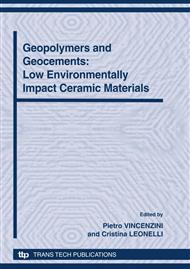p.21
p.31
p.41
p.51
p.57
p.63
p.69
p.75
p.86
Use of Sodium Silicate Gel as Precursor of Binder for Cold Consolidated Materials
Abstract:
Consolidation of cements and geopolymers can be explained by the formation of alkali silicate or alumino-silicate gels formed in situ during materials setting. To control such a system, a study concerning the use of sodium silicate gel as binder was initiated to manufacture consolidated materials with different size distribution of silica. The gels used as precursor of binder were synthesised by acidifying with hydrochloric acid, a concentrated sodium silicate. Consolidated materials were obtained by mixing the previous solution before gelation with granular materials (fine silica powder and sands). The existence domain of consolidated materials depends on the size distribution of sand. Consolidation of material is strong when the amount of silica is high. This result suggests a dissolution / precipitation reaction between gel and silica. Therefore, consolidation could be explained by the dissolution of small particles of silica and their precipitation into the grain boundary of sand. Mechanical properties are closed to those of cement materials.
Info:
Periodical:
Pages:
57-62
Citation:
Online since:
October 2010
Price:
Сopyright:
© 2010 Trans Tech Publications Ltd. All Rights Reserved
Share:
Citation:


